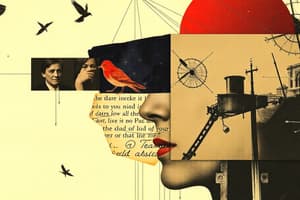Podcast
Questions and Answers
What is the typical length of a Haiku poem?
What is the typical length of a Haiku poem?
- 5 lines
- 3 lines (correct)
- 7 lines
- 10 lines
Which poetic device is used to compare two unlike things without 'like' or 'as'?
Which poetic device is used to compare two unlike things without 'like' or 'as'?
- Alliteration
- Metaphor (correct)
- Simile
- Personification
What is the term for a group of lines in a poem, separated by a blank line or indentation?
What is the term for a group of lines in a poem, separated by a blank line or indentation?
- Quatrain
- Couplet
- Tercet
- Stanza (correct)
Which poetic movement is associated with an emphasis on emotion, imagination, and nature?
Which poetic movement is associated with an emphasis on emotion, imagination, and nature?
What is the term for the pattern of sound and silence in a poem?
What is the term for the pattern of sound and silence in a poem?
Which poetic form is characterized by a specific rhyme scheme and 14 lines?
Which poetic form is characterized by a specific rhyme scheme and 14 lines?
What is the term for the use of objects, colors, or images to represent abstract ideas or concepts?
What is the term for the use of objects, colors, or images to represent abstract ideas or concepts?
Which poetic device is used to create vivid mental images through language?
Which poetic device is used to create vivid mental images through language?
Flashcards are hidden until you start studying
Study Notes
Types of Poems
- Sonnet: 14-line poem, usually written in iambic pentameter, with a specific rhyme scheme
- Haiku: short, three-line poem originating from Japan, typically capturing a moment in time
- Free Verse: poem without a regular rhyme or meter, allowing for more creative expression
- Ode: poem expressing praise or admiration for a person, place, or thing
- Ballad: narrative poem telling a story, often with a folkloric or legendary theme
Poetic Devices
- Metaphor: comparison between two unlike things without "like" or "as"
- Simile: comparison between two unlike things using "like" or "as"
- Alliteration: repetition of initial consonant sounds in words
- Imagery: language that appeals to the senses, creating vivid mental images
- Personification: attribution of human qualities or characteristics to non-human entities
Poetic Forms
- Couplet: two-line stanza with a specific rhyme scheme
- Tercet: three-line stanza with a specific rhyme scheme
- Quatrain: four-line stanza with a specific rhyme scheme
- Stanza: group of lines in a poem, separated by a blank line (or indentation)
Key Poets and Movements
- Romanticism: emphasis on emotion, imagination, and nature (e.g. William Wordsworth, John Keats)
- Victorian Era: focus on social issues, morality, and realism (e.g. Alfred, Lord Tennyson, Elizabeth Barrett Browning)
- Modernism: experimentation with form, language, and meaning (e.g. T.S. Eliot, Ezra Pound)
- Surrealism: exploration of the subconscious, dreams, and the irrational (e.g. André Breton, Sylvia Plath)
Other Important Concepts
- Rhythm: pattern of sound and silence in a poem
- Tone: attitude or feeling conveyed by the poem
- Theme: underlying idea or message of the poem
- Symbolism: use of objects, colors, or images to represent abstract ideas or concepts
Types of Poems
- A Sonnet is a 14-line poem, usually written in iambic pentameter, with a specific rhyme scheme
- Haiku is a short, three-line poem originating from Japan, typically capturing a moment in time
- Free Verse is a poem without a regular rhyme or meter, allowing for more creative expression
- An Ode is a poem expressing praise or admiration for a person, place, or thing
- A Ballad is a narrative poem telling a story, often with a folkloric or legendary theme
Poetic Devices
- A Metaphor is a comparison between two unlike things without "like" or "as"
- A Simile is a comparison between two unlike things using "like" or "as"
- Alliteration is the repetition of initial consonant sounds in words
- Imagery is language that appeals to the senses, creating vivid mental images
- Personification is the attribution of human qualities or characteristics to non-human entities
Poetic Forms
- A Couplet is a two-line stanza with a specific rhyme scheme
- A Tercet is a three-line stanza with a specific rhyme scheme
- A Quatrain is a four-line stanza with a specific rhyme scheme
- A Stanza is a group of lines in a poem, separated by a blank line (or indentation)
Key Poets and Movements
- Romanticism emphasizes emotion, imagination, and nature, with poets like William Wordsworth and John Keats
- The Victorian Era focuses on social issues, morality, and realism, with poets like Alfred, Lord Tennyson and Elizabeth Barrett Browning
- Modernism involves experimentation with form, language, and meaning, with poets like T.S.Eliot and Ezra Pound
- Surrealism explores the subconscious, dreams, and the irrational, with poets like André Breton and Sylvia Plath
Other Important Concepts
- Rhythm is the pattern of sound and silence in a poem
- Tone is the attitude or feeling conveyed by the poem
- A Theme is the underlying idea or message of the poem
- Symbolism involves the use of objects, colors, or images to represent abstract ideas or concepts
Studying That Suits You
Use AI to generate personalized quizzes and flashcards to suit your learning preferences.




